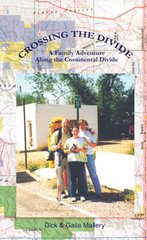
Your CDT hike may or may not include a stop at El Morro Nationa Monument depending on the route you choose. It is well worth a visit.
El Morro National Monument, a much-carved bluff in the high desert of western New Mexico.
Anasazi, with one layer of Spanish colonialism and another of American Manifest Destiny, all seen through the lens of National Park Service stewardship.
OVERALL
Don't think of it as a landscape. Think of it as the best guest ledger in the West, about 200 feet, top to bottom, and made of sandstone.
On it you can find handprints, stick-figure animals and signatures in fancy looping script -- more than 2,000 inscriptions, carved over seven centuries by overland travelers who stopped here to dull their thirst.
"Governor Don Juan de Oñate passed through here, from the discovery of the Sea of the South on the 16th of April, 1605," says one entry in Spanish.
"Miss A.F. Baley," says another, from 1858.
Still, you may not have heard of El Morro National Monument, a.k.a. Inscription Rock, because it's out of the way, even by rural New Mexico standards. South of Gallup, west of Grants. Just up the road from the Pueblo of Zuni, just down the road from the ancient cinders and lava tubes of El Malpais National Monument.
To reach it from Albuquerque, you drive 85 miles west on Interstate 40 to Grants, then take New Mexico 53 for 42 miles. On the way, you climb from the high desert and red rock to the even higher desert with its forests of ponderosa and pinyon pine. You cross the Continental Divide, surrounded by scrub that grows thick and green during the monsoons of July and August, and then a white-orange bluff rises abruptly from the plain, its base about 7,200 feet above sea level. This is El Morro, which translates, more or less, from Spanish as "the headland."
In landscape terms, it's a not a mesa but a cuesta, because it rises in a gradual slope at one end, then drops straight down at the other. Pine and juniper congregate on and around it. A pre-Columbian condo complex sits on top -- about a dozen rooms exposed among an estimated 875 that once held 1,000 residents in the 13th and 14th centuries.
But it's not those dwellings nor the shape of the rock that makes El Morro unique. It's the water and the names.
For hundreds of years, the pool of collected rainfall and snowmelt at the foot of this rock was the only reliable water supply for 30 miles around, maybe more. That made it a standard stopping point for anybody passing through, including the Anasazi of the 13th century, Spanish explorers of the 17th century and American settlers of the 19th century.
Oñate, New Mexico's first Spanish governor, left his mark after a visit to the Gulf of California. Miss Baley, the first woman to sign, was part of a wagon expedition from Missouri to California. There's a 4-inch-high swastika, left by native peoples centuries before the Nazis adopted it. And there's the flowery script of Mr. E. Pen. Long of Baltimore, an 1859 visitor whom you could call the John Hancock of El Morro.
In 1906, the federal government stepped in and banned further inscriptions. Until the 1930s, early rangers used pencils to darken a few of the oldest inscriptions. In their bid to protect the past-tense graffiti from the present-day variety, rangers have put up a couple of sandstone rocks in front of the visitor center to channel the energies of scratch-happy kids.
"Certainly all the other rocks in America do not, all together, hold so much of American history," wrote Charles F. Lummis, the champion of Western history who founded the Southwest Museum in Los Angeles.
Visiting today, you browse the visitor center, then stroll a half-mile loop of the Inscription Trail, moving from petroglyph to signature. Hardier hikers continue up the Headland Trail, which adds 1.5 miles to the journey and climbs 200 feet to the Atsinna Pueblo on top of the rock.
I did the Headland Trail (also known as the Mesa Top Trail) with ranger Aleksu Hillerstrom, who pointed out a tree that had been struck by lightning a month before (that's common in summer) and helped me read between the inscription lines.
One Spanish explorer called himself a gentleman, but one of his contemporaries vigorously crossed out the word. An American in 1849 misspelled the word "inscription" and had to wedge the "r" in after the fact. (Copy editing in stone. Bummer.)
I wouldn't build an entire trip around El Morro, but if you're on the road anywhere between Flagstaff and Albuquerque, it's surely worth a few hours, perhaps an overnight.
You can spend the night at Grants (a town of about 9,000), but the summer temperatures are cooler and the scenery better up around El Morro. In summer, the park service opens nine primitive campsites at the monument. About a mile away on the highway, El Morro RV Park has about two-dozen hook-ups for $20 nightly, three cabins at $65 to $75, and a handful of tent sites for $10.
The neighboring Ancient Way Cafe offers breakfast, lunch and dinner, and the Inscription Rock Trading & Coffee Co. offers snacks and gifts, and the nonprofit Old School Gallery shows art.














